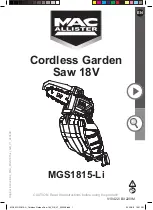
Customer Helpline
0333 3201989
11
Operating Instructions
FLUSH CUTTING (SEE FIG G1, G2)
Pay attention that the saw blade always extends beyond the diameter of the
material being worked�
There is danger of kickback.
It is possible to make cuts extremely close to floors, walls and other difficult areas. Insert
the blade shank into the blade clamp with the blade teeth facing up (opposite to normal
working position). This will make cuts closer to the work surface. Using special flexible
blades insert the blade into the blade clamp with the blade teeth facing down (normal
working position). It will allow flush pipe cutting.
WOOD CUTTING
For easier control use low speed to start cutting, then increase to the correct speed.
METAL CUTTING
This saw has different metal cutting capacities depending upon the type of blade being
used and metal being cut.
Use a finer blade for ferrous metals and a coarse blade for non-ferrous metals.
When cutting thin gauge sheet metals,
ALWAYS
clamp wood on both sides of the sheet.
This will give you a clean cut without excess vibration or tearing of the metal.
DO NOT
force the cutting blade. Forcing the blade will reduce blade life and cause the blade
to break.
NOTE:
We recommend that you spread a thin film of oil or other coolant along the line of
cut ahead of the saw. This will allow easier operation and help extend blade life. When
cutting aluminum, use kerosene.
G1
G2






































